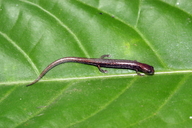|
Thorius smithi Hanken & Wake, 1994
Smith's Minute Salamander | family: Plethodontidae subfamily: Hemidactyliinae genus: Thorius |
 © 2010 Sean Michael Rovito (1 of 3) |
|
|
|
Description Unlike most of its close relatives, T. smithi has maxillary teeth. Three other species of Thorius also contain maxillary teeth, T. aureus, T. schmidti, and T. maxillabrochus, but they are much larger and none of them are sympatric with T. smithi. In addition, T. aureus has a much lighter ventral coloration, T. schmidti has less rounded nostrils, and T. maxillabrochus has wider feet and more rounded toe tips. Thorius insperatus, which is the only member of the genus Thorius sympatric with T. smithi, does not have maxillary teeth and has rounded, rather than pointed, toe tips. Other members of the genus may also bear some resemblance to the species. Thorius smithi can be distinguished from its congeners in the Sierra de Juárez - T. macdougalli, T. arboreus, and T. boreas - by its more rounded nostril, smaller size, and the presence of maxillary teeth (Hanken and Wake 1994). In life, it is a rich dark brown, with an obscure, dull, faint dorsal stripe extending from near the eyes onto the tail. The sides of the stripe have a dark dorsolateral band that also extends onto the tail. The flanks and venter of this species are lighter and have copious white spots (0.1 - 0.2 mm in diameter), which are especially numerous by the throat. The limbs have some white spots as well, and match the rich brown of the flanks. The iris is charcoal colored (Hanken and Wake 1994). This species has only been described from two specimens. In one of the specimens, the tail length exceeded the body length. Due to the small number of specimens studied, there is no other information on variation within the species (Hanken and Wake 1994). Distribution and Habitat Country distribution from AmphibiaWeb's database: Mexico
Life History, Abundance, Activity, and Special Behaviors Trends and Threats Possible reasons for amphibian decline General habitat alteration and loss Comments No biochemical analyses have been performed to determine the phylogenetic relationship of T. smithi to other Thorius species (Hanken and Wake 1994). The species epithet, smithi, is derived from H. M. Smith, who contributed greatly to Mexican herpetology, including the taxonomy of Thorius (Hanken and Wake 1994). Thorius salamanders are extremely hard to distinguish morphologically by virtue of their very small size, and in many instances, can only be accurately distinguished through biochemical data (Hanken and Wake 1994).
References
Hanken, J., Wake, D. B. (1994). ''Five new species of minute salamanders, genus Thorius (Caudata: Plethodontidae), from Northern Oaxaca, Mexico.'' Copeia, 1994(3), 573-590. Parra-Olea, G., Wake, D. B., Hanken, J. (2008). Thorius smithi. The IUCN Red List of Threatened Species. Version 2014.3. www.iucnredlist.org. Downloaded in March 2015. Originally submitted by: Alicia Beattie (first posted 2015-06-24) Edited by: Gordon Lau (2015-07-06) Species Account Citation: AmphibiaWeb 2015 Thorius smithi: Smith's Minute Salamander <https://amphibiaweb.org/species/4214> University of California, Berkeley, CA, USA. Accessed May 30, 2025.
Feedback or comments about this page.
Citation: AmphibiaWeb. 2025. <https://amphibiaweb.org> University of California, Berkeley, CA, USA. Accessed 30 May 2025. AmphibiaWeb's policy on data use. |


 Raffaëlli Account
Raffaëlli Account Map of Life
Map of Life